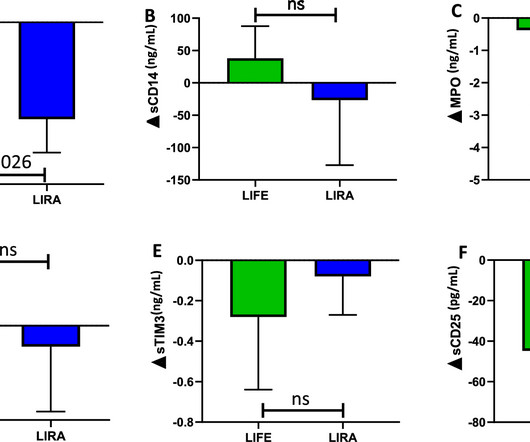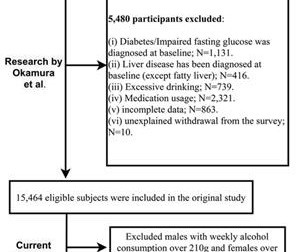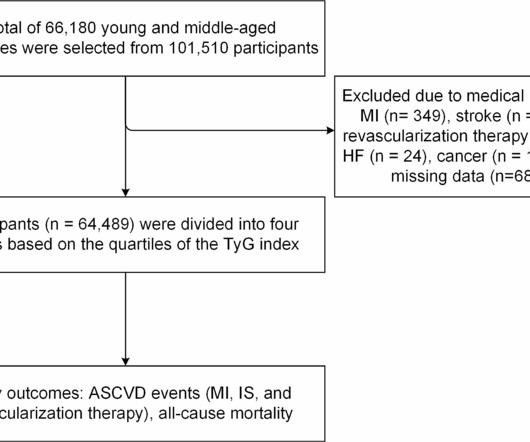When female doctors treat female patients
Heart Sisters
APRIL 28, 2024
Several theories have emerged in medicine to explain surprising differences in patient outcomes based on whether our doctor is male or female.

Heart Sisters
APRIL 28, 2024
Several theories have emerged in medicine to explain surprising differences in patient outcomes based on whether our doctor is male or female.

Dr. S. Venkatesan MD
APRIL 28, 2024
(This is supposed to be a poll. Sorry, readers, you can’t select the answer. WordPress is not kind enough and suddenly made the poll service payable extra. I am already paying nearly a $100 fee to maintain this site. I can’t afford any more.) We have been taught Bi-Atrial enlargement is the rule in AF.It is still true in most situations.

Cardiovascular Diabetology
APRIL 28, 2024
The GLP-1 receptor agonist liraglutide is used to treat hyperglycemia in type 2 diabetes but is also known to induce weight loss, preserve the beta cell and reduce cardiovascular risk. The mechanisms underlyin.

Frontiers in Cardiovascular Medicine
APRIL 28, 2024
ObjectiveWhile hypertension is a well-recognized risk factor for non-alcoholic fatty liver disease (NAFLD), the specific roles of various common blood pressure measurements [diastolic blood pressure (DBP), systolic blood pressure (SBP), pulse pressure (PP), mean arterial pressure (MAP)] in detecting NAFLD and evaluating the associated risk in adults remain unclear.MethodsA retrospective analysis was conducted on 14,251 adult participants undergoing health screenings in the NAfld in the Gifu Area

Speaker: Simran Kaur, Co-founder & CEO at Tattva.Health
AI is transforming clinical trials—accelerating drug discovery, optimizing patient recruitment, and improving data analysis. But its impact goes far beyond research. As AI-driven innovation reshapes the clinical trial process, it’s also influencing broader healthcare trends, from personalized medicine to patient outcomes. Join this new webinar featuring Simran Kaur for an insightful discussion on what all of this means for the future of healthcare!

Cardiovascular Diabetology
APRIL 28, 2024
The association between the triglyceride glucose (TyG) index and the risk of early-onset atherosclerotic cardiovascular disease (ASCVD) events or all-cause mortality in young and middle-aged people is not full.

Frontiers in Cardiovascular Medicine
APRIL 28, 2024
AimPulmonary artery banding serves as an important palliative procedure used for the management of several congenital heart lesions. This study aims to describe a 20-year experience of pulmonary artery banding at a tertiary care center in a developing country.MethodsThis is a retrospective chart review of patients who underwent pulmonary artery banding over a 20-year period between January 2000 and July 2020 in a tertiary care center in a developing country.
Cardiovascular Update brings together the best content for cardiovascular medicine professionals from the widest variety of industry thought leaders.

HCPLive
APRIL 28, 2024
Patients with RA reported worse outcomes for all PROMs compared with CSA or UA.

Circulation
APRIL 28, 2024
Circulation, Volume 149, Issue 18 , Page 1457-1460, April 30, 2024.

HCPLive
APRIL 28, 2024
Preliminary findings demonstrate an improvement in eGFR slope in nearly all patients with SCD after treatment with SGLT-2 inhibitors and GLP-1 receptor agonists.

Circulation
APRIL 28, 2024
Circulation, Volume 149, Issue 18 , Page 1461-1465, April 30, 2024.

HCPLive
APRIL 28, 2024
This observational cohort study looked at the link between obesity and eczema, highlighting regional differences in the skin disease and obesity’s interdependence.

Coronary Artery Disease Journal
APRIL 28, 2024
No abstract available

Journal of Cardiovascular Pharmacology
APRIL 28, 2024
An abstract is unavailable. This article is available as a PDF only.

HeartRhythm
APRIL 28, 2024
Early detection of atrial fibrillation (AF) is key for preventing strokes. Blood pressure monitors (BPMs) with built-in AF screening features have the potential for early detection at home. Recently, two BPMs (HEM-7371T1-AZ and HEM-7372T1-AZAZ, OMRON HEALTHCARE Co., Ltd.) which share a novel AF screening feature have been developed. Their AF screening feature utilizes an algorithm which incorporates machine learning, with the potential to improve diagnostic accuracy.

Journal of Cardiovascular Pharmacology
APRIL 28, 2024
An abstract is unavailable. This article is available as a PDF only.

HeartRhythm
APRIL 28, 2024
Due to increasing use of cardiac implantable electronic devices (CIEDs) with one or more intracardiac electrodes, the rate of lead failure is increasing. Moreover, an upgrade of the CIED is frequently indicated for cardiac resynchronization therapy or other reasons. Both these situations require a new intervention, preferably using the ipsilateral venous access.

The American Journal of Cardiology
APRIL 28, 2024
Publication date: Available online 27 April 2024 Source: The American Journal of Cardiology Author(s): Rafic F.

HeartRhythm
APRIL 28, 2024
Single-lead electrocardiograms (1L ECG) are increasingly used for atrial fibrillation (AF) detection. Automated 1L ECG interpretation may possess prognostic value for future AF among cases where screening does not result in a short-term AF diagnosis.

All About Cardiovascular System and Disorders
APRIL 28, 2024
Pulmonary embolism is obstruction of blood vessels of the lungs by clots carried by blood circulation, usually from the legs. It is a serious life threatening condition and hence trying to prevent it is very important. Clots can also migrate from blood vessels of the tummy, but that is not easy to prevent. Blood clots can form in the veins or blood vessels returning deoxygenated blood to the lungs for enrichment with oxygen.

HeartRhythm
APRIL 28, 2024
Left bundle branch (LBB) area pacing (LBBAP) has become a cardiac resynchronization therapy (CRT) modality in patients with heart failure (HF) and LBB block (LBBB). LBB pacing (LBBP) and left ventricular (LV) septal myocardial pacing (LVSP) are the two pacing modalities of LBBAP(1). However, the electrophysiological differences between LBBP and LVSP and the methods to differentiate LBBP from LVSP in patients with HF and LBBB need investigations.
Let's personalize your content